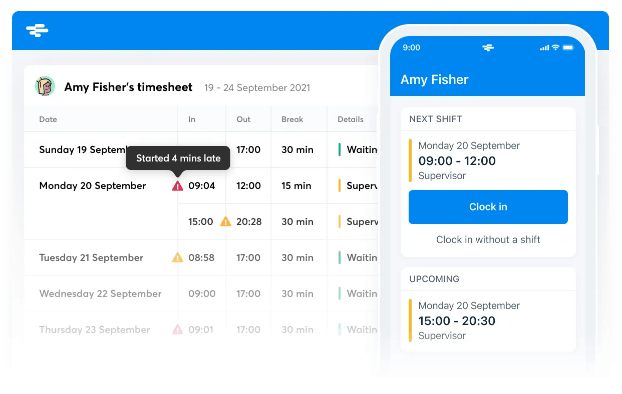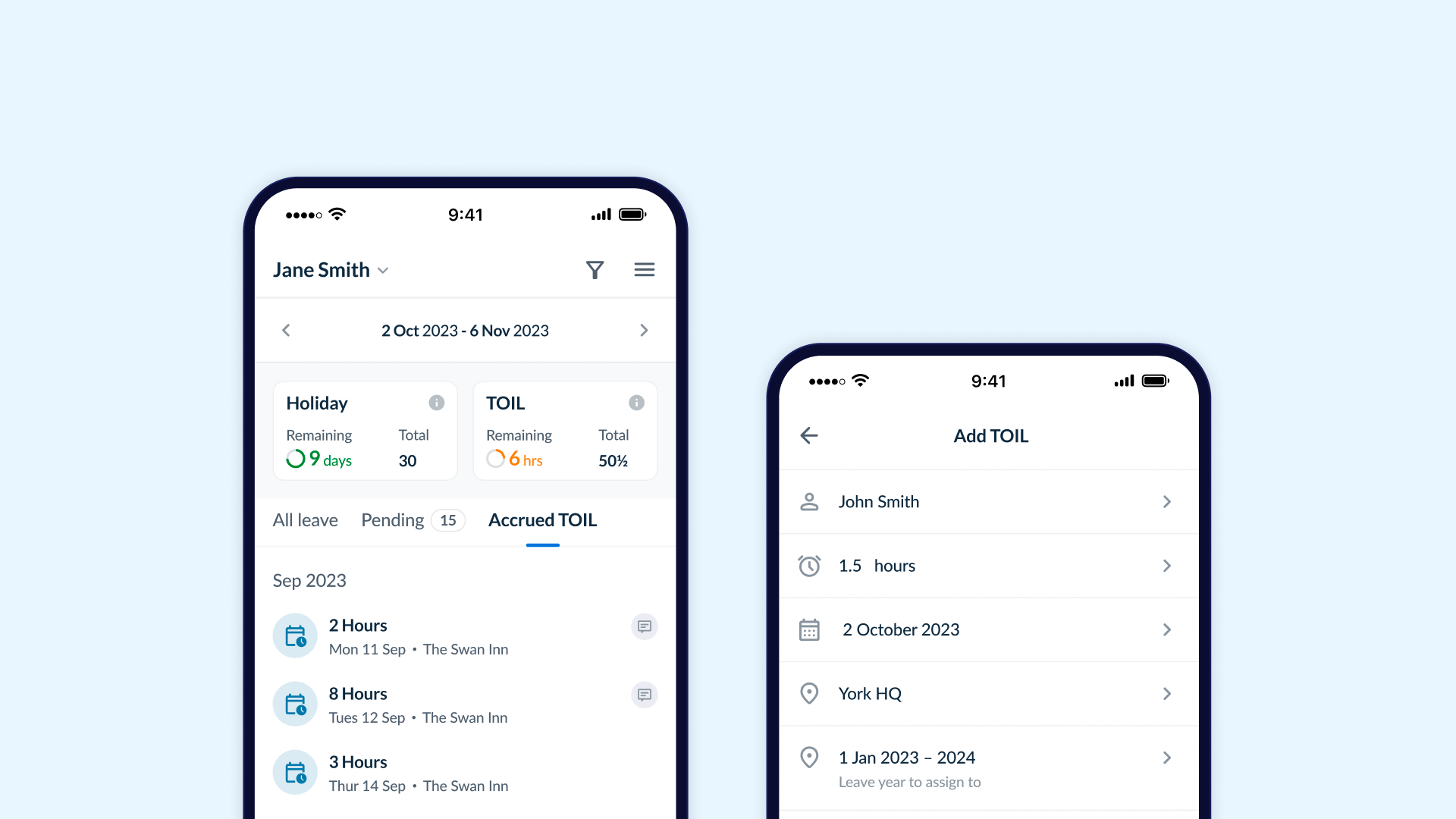Overtime is par for the course for a lot of shift-based workers, with sudden fluctuations in demand requiring staff to remain at work slightly longer than scheduled.
In the past, many employers would offer their staff overtime pay in exchange for working extended hours. Increasingly, however, businesses are opting to give their staff time off in lieu (TOIL) — additional paid leave in place of overtime pay.
To help you decide whether time off in lieu is right for your business, we've prepared this simple introduction to the process, outlining everything from frequently asked questions about time off in lieu, to the pros and cons of offering it, to how best to manage it.
Skip to:
What is time off in lieu (TOIL)?
Is time off in lieu a legal requirement for employers?
How to manage time off in lieu (TOIL)
What does “in lieu” mean?
You'd be forgiven for not knowing what "lieu" means since it's actually a French word that we've adopted into English.
Most commonly pronounced either “in lee-oo” or just “in loo” (and often misspelt as "lou", "leiu" or "leui" - those pesky 'i' and 'e's!), it simply means “instead of” or “in place of”.
The phrase is commonly used in workplace environments when discussing pay, overtime, and annual leave. For example:
- “Kate went home 15 minutes early in lieu of her missed break.”
- “Andy worked on Sunday so took Monday off in lieu.”
- “The supplier offered a discount on our next order in lieu of a refund.”
More often than not, "in lieu" is used in relation to taking time off work, i.e. time off in lieu...
What is time off in lieu (TOIL)?
Time off in lieu, often abbreviated as TOIL or TIL, is used to describe the process of giving an employee additional leave instead (or “in lieu”) of paying them for the time that they’ve worked above their scheduled or contracted hours.
The amount of leave given to an employee is usually equivalent to the number of hours of overtime they worked during the pay period. However, it's common for TOIL leave to be built up incrementally over several weeks or months.
In some cases, TOIL is added to an employee’s total annual leave allowance for the year, but other employers may choose to log any accrued time off in lieu separately.
It’s important to note that time off in lieu is paid leave. This is because the holiday is being offered instead of pay for additional hours already worked.
Is time off in lieu a legal requirement for employers?
Under the time off in lieu policy, UK employers are not legally required to offer their staff time off in lieu of overtime pay. However, they are free to do so provided that the conditions for accruing and taking TOIL leave are clearly documented in their employment contracts - and that Working Time Regulations aren’t breached as a result.
From the employee’s side, staff can request time off in lieu of receiving overtime pay, but employers are under no legal obligation to agree to the proposal.
By the same token, employers cannot force an employee to take time off in lieu of receiving any overtime pay that they might be owed according to their employment contract.
So, should you be using TOIL at work?
The pros and cons of offering time off in lieu (TOIL) at your business

There are several good reasons why, as an employer, you might choose to include TOIL in your employment contracts.
But before you decide to implement a time off in lieu scheme at your business, it's important to be aware of both the pros and the cons of offering annual leave in place of offering overtime pay.
The benefits of TOIL
1. TOIL helps keep labour costs under control
Paying overtime can be costly — especially when it’s unexpected. By giving your staff extra time off instead of paying them for working overtime, you'll be better able to stick to your budget and keep labour costs under control.
2. Staff have more time to recuperate
Regular bouts of overtime can be mentally and physically draining for staff. Rather than simply paying them for the extra hours they work, giving staff additional annual leave allows them time to fully rest and recuperate between busy periods.
3. Staff feel more in control of their work lives
With extra holidays in the bank, staff will be better able to respond to unexpected life events and spend more time with friends or family, helping to boost their overall well-being and creating a better employee experience at your business.
Offering your staff time off in lieu clearly has the potential to benefit both your staff and your business.
But what about the cons of time in lieu?
Common problems with TOIL
1. Some staff would prefer the cash
While some staff will appreciate having more paid time off, the odd day in lieu, others will naturally prefer to be paid for the extra hours they put in. In fact, if you work in an industry where overtime is common, some staff may have actually been banking on it.
2. TOIL has to be built up over time
Any amount of overtime pay can be immediately added to an employee’s overall pay after working it. However, staff who receive time off in lieu of pay must build up a set amount of TOIL leave before they can actually make use of it. This can be frustrating for staff, especially those who only occasionally work more than their contracted hours.
3. Staff can end up with too much annual leave
It’s not unheard of for staff to reach the end of their work year with an abundance of unused annual leave — and that’s before you add TOIL to the equation. This can leave you dangerously short-staffed as employees try to use up their remaining holidays before the end of the year.
How to manage time off in lieu (TOIL)

Whether or not time off in lieu will be right for your business will depend on everything from the type of work your staff do, to how often they work overtime, to whether you have a system in place for calculating any additional time off staff have accrued and how they can redeem it.
If you do decide to offer time off in lieu of overtime pay at your business, here are some basic tips for managing it effectively.
Make the rules clear to your team
Start by ensuring that the way your staff accrue time off in lieu of overtime is clearly stated in your company handbook and employment contracts.
A few things you might want to consider and include in your documentation surrounding TOIL:
- The minimum amount of overtime worked before TOIL can be accrued (does it begin right after their scheduled finish time, or will it be logged in 15-minute increments?)
- The minimum amount of TOIL that must be accrued before TOIL leave can be taken (can staff use an hour or TOIL leave, or will they need to accrue and book an entire day?)
- Any upper limits and deadlines for using accrued TOIL leave
- Whether TOIL is added to employees’ overall leave allowance or treated separately
- How staff book TOIL leave (more on this below...)
If everything's laid out in black and white from the start, then there should be no confusion about how the TOIL system works at your business.
Establish how TOIL will be recorded
If your staff accrue time off in lieu of being paid for working overtime, then it’s vital that you keep an accurate record of the hours they started and finished their shifts — as well as how much of that time counts towards TOIL leave.
Admittedly, this can involve a fair amount of admin on your part, but records will need to be kept from month to month, with any instances of overtime tallied and staff made aware when they’ve built up enough TOIL leave to redeem.

Automatic timesheets for your team
RotaCloud automatically logs your team's start, finish, and break times — saving you hours of data entry and making calculating payroll simple.
Create a simple process for booking TOIL
Just like with regular annual leave, your staff should be able to check how much TOIL leave they've accrued and use it as and when they need to.
If TOIL leave is recorded and taken separately from employees’ regular annual leave allowance, then your staff will need a simple way of communicating that they want to book TOIL instead of using a regular holiday. For instance, by checking a box on a leave request form or using a different form altogether.
Either way, make sure that your employees can easily see how much TOIL leave they’ve accrued and understand the process for requesting time off.
Managing time off in lieu using RotaCloud

A simpler method of managing time off in lieu is to automate the process using people management software such as RotaCloud.
RotaCloud’s suite of leave management tools makes it easy to record not only annual leave but also time off in lieu for your staff.
Available across all pricing plans, our TOIL feature allows managers to quickly add TOIL leave to employees’ leave allowances if they work more than their scheduled hours. TOIL leave is logged separately from regular holidays on employees’ RotaCloud accounts, meaning that staff can see how much of each leave type they’ve built up or have remaining.
The process of requesting TOIL leave is just as easy as requesting a holiday: staff simply submit a leave request in the usual way via the RotaCloud mobile app, this time selecting TOIL as the leave type instead of Holiday. The leave request is then delivered to you to check before approving or denying it with the click of a button.
You can read more about RotaCloud’s TOIL feature here.
Wrap-up
TOIL, or time off in lieu, is the practice of offering your staff additional paid leave in exchange for working overtime.
For some businesses, this is preferable since it allows managers to keep their labour costs consistent from week to week and avoid unexpectedly highly wage bills.
It's important to consider both the pros and cons of offering TOIL at your business, such as whether your staff would prefer to receive overtime pay instead, and whether they'd realistically be able to accrue enough TOIL leave to make use of it.
Whichever system you opt for, be sure to document the rules clearly and ensure that staff have a simple, streamlined way of checking and requesting their remaining annual leave when they need to.
Read next ➤

How to calculate holiday accrual for hourly staff [calculator]
Calculate holiday entitlement based on hours worked with our holiday accrual calculator.
More TOIL FAQs
What is lieu time?
Lieu time is just another way to describe TOIL. Whether it's a lieu day or a few hours, the lieu time is extra worked hours that staff can build up and take as paid leave.
What does TOIL stand for?
The TOIL acronym stands for 'time off in lieu'. Employees can be given TOIL (additional paid leave) instead of being paid for overtime.
Do you get paid for lieu days?
Yes. By working overtime, staff can be given TOIL as paid leave on top of their holiday entitlement. It makes up for the extra time in lieu of paying for overtime.
Editor's Note: This post was originally published in September 2023 and updated for accuracy in March 2024 and January 2025.







